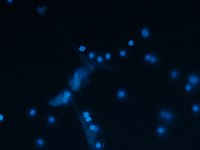
Photo from wikipedia
In Response: We thank Bourcier et al for their interest in our recent study. In their letter, they state that “specific immunostaining techniques are mandatory to quantify platelet content in… Click to show full abstract
In Response: We thank Bourcier et al for their interest in our recent study. In their letter, they state that “specific immunostaining techniques are mandatory to quantify platelet content in thrombi.” Platelets are a significant component of thrombi as shown by Niesten et al and Staessens et al. Platelets are contiguous with the fibrin and, therefore, contribute significantly to the cohesiveness and strength of the fibrin network. The main finding from our study is that cases that require multiple passes to achieve revascularization have fewer red blood cells in clot fragments captured in the later passes of the case and have a higher fibrin composition. Based on current understanding, it is likely that fibrin dominant regions contain attached platelets, thereby resulting in the same study conclusions. Preclinical models have also shown that fibrin rich clots are stiffer and more difficult to remove than red blood cell–rich clots. Immunohistological staining is still requisite to identify the presence of platelets and, while not part of the initial analysis, it is planned for future work. Despite this, the clot analysis applied in this study is in keeping with published studies that examined the red blood cell, fibrin, and white blood cell content of thrombi using Martius Scarlet Blue staining. In their correspondence, Bourcier et al highlighted the issue of using the histological findings as a gold standard in large vessel occlusions. The authors agree that the histological analysis of thrombi has limitations. These include the inability to compare the morphology of the occlusive thrombus in the vessel with the retrieved specimen, the uncertainty of how thrombus composition is altered after thrombolytic therapy or mechanical thrombectomy, and the inability to analyze thrombus material that was not successfully retrieved. As suggested by Bourcier et al, imaging studies may help to overcome these limitations. The absence of imaging analysis in this study is a limitation; however, it was beyond the scope of this work. Despite the lack of imaging findings, the histological per-pass approach adopted in this study has, for the first time, provided insight into thrombus composition during each procedural pass, which imaging may not readily permit. Overall, combining per-pass analysis of thrombi using histological analysis with imaging and immunohistochemical methods would provide a comprehensive approach that has the potential to provide further insight into mechanical thrombectomy in large vessel occlusions.
Journal Title: Stroke
Year Published: 2019
Link to full text (if available)
Share on Social Media: Sign Up to like & get
recommendations!